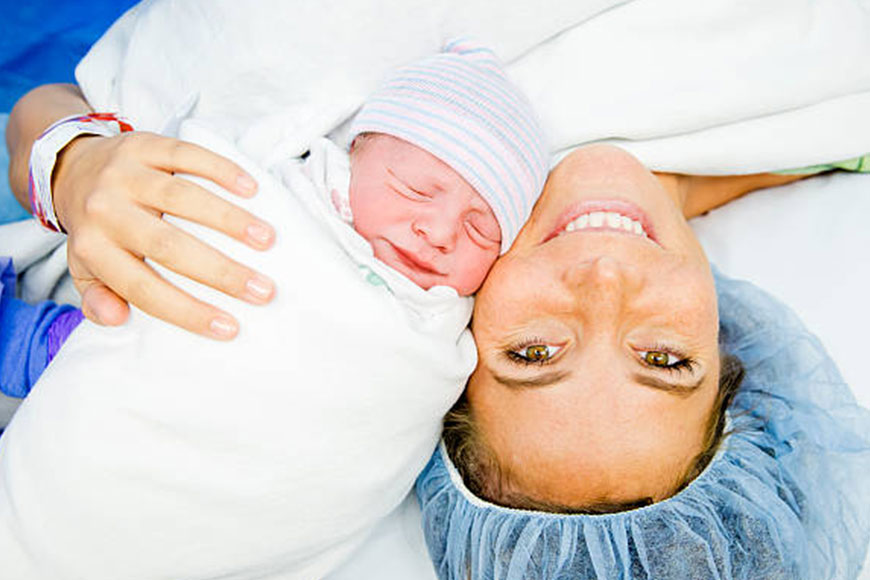If you’re pregnant again and your last baby arrived by caesarean section, you may be wondering if a vaginal delivery could be an option for you this time around. A vaginal delivery after a cesarean delivery (VBAC) is possible for many women, but there are factors that help you and your doctor decide if it’s right for you.

The most important thing to consider is the safety of you and your baby. VBAC is not always the safe for every woman.
If you attempt a vaginal birth and are at high risk of complications, it can cause serious problems for you and your baby – some of which can even be life-threatening. That is why it is important that you talk to your doctor about the risks.
For you and your doctor to consider natural childbirth, you and your baby must be healthy. You may be able to try VBAC if you are pregnant with twins, if your doctor says you are all healthy.
Your doctor may suggest that a VBAC is too risky for you to succeed in a natural birth. Risks also include any of the following:
- Obesity (your BMI of 30 or higher)
- Preeclampsia (high blood pressure during pregnancy)
- Age (usually over 35)
- Your previous caesarean delivery was in the last 19 months
- The fetus is very large
- Previous C-section scar
An important detail that you and your doctor should discuss is the type of C-section scar you have on your uterus. (This may be the same type of scar you have on your stomach, but it may go in a different direction.) Doctors make incisions (cuts in the abdomen and uterus) in the two different directions during a C-section:
Cutting my head goes from top to bottom
A cross cut goes from side to side
If the C-section scar is vertical, you cannot try VBAC. There is a high risk that your scar will rupture (rupture or rupture) when attempting a vaginal birth, which can cause significant harm to you and your baby. You will need to have the C-section again.
If your C-section scar is low and transverse, your doctor may allow you to try VBAC, if your other risk factors are low.
Hospital affairs
Check with your doctor early to see if the hospital you’re using allows women to try VBAC. Not every hospital does this.
Although the risk of your old scar rupturing during a VBAC is low, the hospital must be prepared to handle the emergency that may arise if this occurs. Some hospitals are simply not prepared to deal with it.
Low risk vs no risk
There is a very small chance for every woman trying a VBAC that her uterus will rupture, even if she has a low, transverse C-section scar and is otherwise healthy. Doctors cannot be 100% sure whether or not this may happen to you.
Although lacerations occur in less than 1% of VBAC attempts, some women do not want to try it at all, because if they do occur, they can be very dangerous. You need to weigh your options and talk to your doctor before deciding what to do.
VBAC Benefits
If a VBAC is an option for you and you like the idea of trying a natural birth, there are many reasons you might want to try it. There is a good chance of success: About 70% of women who try to have their children vaginally. For the rest, a cesarean delivery is required, because of the problems that appear during the attempt.
You may want to give VBAC a try for many reasons because if it is successful, it will have the following benefits:
- Does not require surgery
- Less blood loss
- faster recovery
- Decreased chance of infection
- You are less likely to get an injury to your bladder or intestines
- You are likely to have fewer problems with childbirth in the future
A case of scar rupture can be fatal for both the mother and the baby. To avoid this, Dr. Bandana stated that the following criteria should be followed:
- The gap between the two pregnancies is important when considering a vaginal delivery after a cesarean delivery. A gap of at least 18 months is required for vaginal delivery after cesarean delivery. You can’t even attempt a natural delivery if the gap is less than that.
- The weight of the baby in the ninth month will also determine whether a natural birth after a cesarean delivery is possible or not.
- The baby should be positioned face down for vaginal delivery after cesarean delivery.
- There should be a spacious passage for the child. The pelvis should be suitable for the passage of the child.
- The reason for the cesarean delivery during the first pregnancy should also be known. This helps diagnose whether the same risk factors are present during the current pregnancy.
- The sequence and thickness of the scar should also be checked for vaginal delivery after cesarean delivery.
- Deviation from any of the above risk factors can be fatal for both the mother and the baby. Obesity and women over the age of 40 are also at risk of stillbirth during vaginal delivery after a cesarean delivery.

